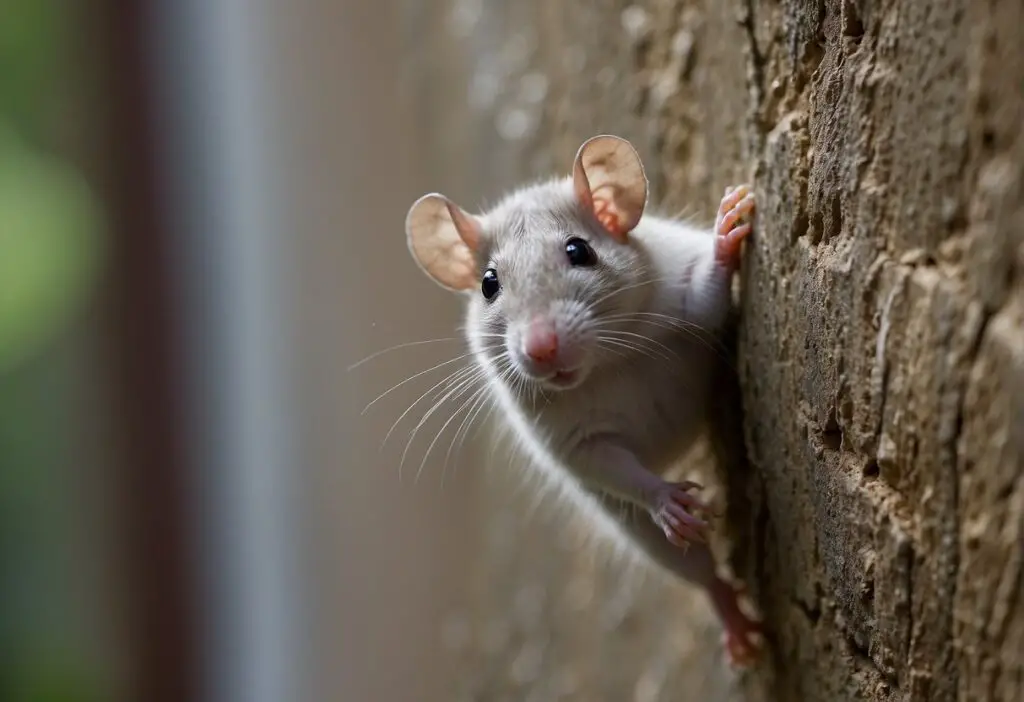If you’ve ever had a rat infestation, you know how frustrating it can be to keep them out of your home.
Rats are notorious for their climbing abilities, and they can easily scale walls to gain access to your home. Fortunately, there are steps you can take to stop rats from climbing your walls and entering your home.

One of the most effective ways to prevent rats from climbing your walls is to use a smooth surface at the base of the wall. According to City Pests, rats can’t climb smooth surfaces, so using a sheet of plastic or laminate secured to the base of the wall can help keep them out. However, it’s important to note that rats can still climb other objects like drain pipes and cables, so it’s important to address these potential entry points as well.
Another way to prevent rats from climbing your walls is to seal any potential entry points. This can include gaps around windows and doors, as well as holes in the walls or roof. According to The Pest Informer, effective sealing of entry points is necessary to prevent rat infestations. Additionally, trimming trees and vegetation around your home can help prevent rats from accessing your roof and walls.
Understanding Rat Behavior
If you are dealing with a rat infestation, it is important to understand their behavior to effectively get rid of them. Rats are excellent climbers, and they can climb walls, pipes, and wires with ease. They can also jump up to three feet vertically and four feet horizontally. In this section, we will discuss rat climbing abilities and common entry points.
Climbing Abilities
Rats are natural climbers and can climb almost any surface, except for smooth surfaces. They use their sharp claws to grip onto rough surfaces and climb up. They can also use their tails to balance themselves while climbing. Roof rats, in particular, are excellent climbers and can climb trees, vines, and even telephone poles. They can easily climb up to your roof and find their way into your attic.
Common Entry Points
Rats can enter your home through small openings, cracks, and crevices. They can squeeze through holes as small as a quarter. Some common entry points for rats include:
- Gaps around pipes and wires
- Holes in walls and foundations
- Openings around windows and doors
- Vents and exhaust fans
To prevent rats from climbing your walls and entering your home, you should seal any openings or gaps in your home’s exterior. You can use steel wool, caulk, or foam insulation to seal these gaps. You can also use a smooth surface like a sheet of plastic or laminate secured to the base of the wall to prevent rats from climbing up. By taking these preventative measures, you can keep rats out of your home and avoid a rat infestation.
Preventative Measures
If you want to prevent rats from climbing your walls, you need to take some preventative measures. Here are some effective ways to keep rats from scaling your walls:
Securing the Perimeter
Rats can enter your property through holes, gaps, and crevices in your walls, so it’s important to secure the perimeter of your property. Check for any gaps or holes in your walls, pipes, and wiring, and seal them with mesh or caulk. You can also install wall guards to prevent rats from climbing up your walls.
Landscaping and Maintenance
Rats are attracted to overgrown areas and food waste, so it’s important to keep your property clean and well-maintained. Trim trees and vegetation away from your walls, and remove any food waste or debris from your property. You can also use capsaicin-based repellents to deter rats from entering your property.
Home Fortification
If you have a rat infestation, you may need to fortify your home to prevent them from entering. Install stable fencing around your property, and use ventilation bricks to prevent rats from entering your home through the roof. You can also use wire mesh to cover any holes or gaps in your walls.
Remember, rats can climb rough surfaces like brick walls and pipes, so it’s important to make sure your walls are smooth and free of cracks. By taking these preventative measures, you can prevent rats from climbing your walls and entering your home.
Rat Deterrent Strategies
If you’re dealing with rats climbing your walls, there are several strategies you can use to deter them. In this section, we’ll cover natural repellents, physical barriers, and traps and baits.
Natural Repellents
One way to deter rats from climbing your walls is to use natural repellents. Peppermint oil is a popular choice, as rats are known to dislike the scent. You can soak cotton balls in peppermint oil and place them near areas where rats are likely to climb. Chili peppers are another option, as rats are sensitive to their spicy scent. You can sprinkle crushed chili peppers around the base of your walls.
Physical Barriers
Physical barriers can also be effective in preventing rats from climbing your walls. Rodent repellent tape is a popular choice, as it creates a sticky surface that rats can’t climb. Sharp nails or screws can also be effective, as rats will have trouble gripping onto the surface. Glass surfaces are impossible for rats to climb, so installing glass panels at the base of your walls can be an effective deterrent.
Traps and Baits
Traps and baits are another option for dealing with rats. Snap traps are a classic choice, and can be effective when placed near areas where rats are likely to climb. Glue traps are another option, but can be inhumane and should be avoided if possible. Poison baits can be effective, but should be used with caution as they can be harmful to pets and children.
Remember, different types of surfaces can affect a rat’s climbing abilities. Smooth surfaces like glass or metal can be more difficult for rats to climb than rough surfaces like brick or wood. By using a combination of natural repellents, physical barriers, and traps and baits, you can effectively deter rats from climbing your walls and invading your home.
Rat Infestation Solutions
Identifying Infestations
If you suspect that you have a rat infestation, it is important to take action as soon as possible. Rats can cause a lot of damage to your home, contaminate your food, and spread disease through their droppings. The first step in dealing with a rat infestation is to identify the signs of their presence. Look for rat droppings, gnaw marks on food, building materials, or electrical wiring, and signs of rat nests in your attic or other areas of your home.
Professional Pest Control
While there are many rat traps and other DIY solutions available, sometimes it is best to call in the professionals. Professional pest control services have the knowledge and experience to identify the type of rat infestation you have and the best way to remove them from your home. They can also help you minimize the risk of future infestations by repairing any entry points and advising you on how to store food and dispose of trash properly.
If you decide to use rat traps, make sure to use snap traps or live traps, as they are the most effective. Place the traps in areas where you have seen rat activity, such as in your attic or near rooftops, drainpipes, or gutters. Make sure to bait the traps with something that will attract the rats, such as peanut butter or cheese.
Remember that rats are excellent jumpers, so make sure that any traps you use are placed high enough to prevent them from jumping over them. Once you have caught a rat, make sure to dispose of it properly to prevent the spread of disease.
In conclusion, rat infestations can be a serious problem for homeowners. By taking the appropriate steps to remove rats from your home and prevent future infestations, you can protect your family and your property from these home invaders. Whether you choose to use DIY solutions or seek professional help, it is important to act quickly and decisively to remove rats from your home.
Frequently Asked Questions

Can Rats Climb Smooth Surfaces?
Yes, rats can climb smooth surfaces such as walls, pipes, and poles. However, it is easier for them to climb rough or textured surfaces. According to City Pests, rats have a strong grip and can climb up to 12 feet vertically on a smooth surface. To prevent rats from climbing smooth surfaces, you can use a smooth material like plastic or laminate secured to the base of the wall.
How High Can Rats Jump?
Rats are excellent jumpers and can jump up to 3 feet vertically and 4 feet horizontally. This means that rats can easily jump from the ground to a table or countertop. According to The Pest Informer, rats can also jump from trees or buildings to gain access to a roof or attic. To prevent rats from jumping into your home, make sure to trim tree branches and seal any gaps or holes in your roof or walls.
What Can Rats Not Climb?
Rats can climb most surfaces, but they have difficulty climbing smooth, slippery, or vertical surfaces. According to Reject Rats, rats cannot climb surfaces that are completely smooth, such as glass or polished metal. They also have difficulty climbing vertical surfaces that have no ledges or handholds. To prevent rats from climbing, you can use materials like metal flashing, mesh wire, or sticky tape.
Remember, rats are excellent climbers and can easily access your home through small gaps or openings. By using the right materials and techniques, you can prevent rats from climbing and keep your home rat-free.








